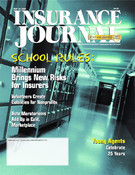Could it be that the California nonstandard auto market is hardening? Looking back to the beginning of the year, many companies lowered their personal auto rates in California in an effort to gain market share, but now-five months later-those companies are paying the price.
The most recent moratoriums on the private passenger auto business include Midland Risk, Condor, Harleysville, Leader Preferred and Harbor Specialty Insurance Company. “Those are the ones that have just cut their programs loose, either temporarily or permanently,” said Fred “Sonny” DiMeo, a broker for San Jose-based Coast Auto Insurance Services Inc. and director of the Independent Broker Network (IBN).
Companies are taking the necessary steps to keep their programs alive. Some have discontinued their annual policies and have switched to a six-month policy. “The six-month policy in one case is actually 55 percent of an annual premium, in essence, giving them a 10 percent increase,” DiMeo said. “Other companies-who will remain nameless-have forced mileage on their clients.” In other words, for the company to get a higher premium, it needs to make sure all of its policies are at a specific annual mileage or greater so that the premium stays above a certain threshold.
The moratorium situation seems to be affecting companies with newer programs-those that don’t have a seasoned book of business. For example, Harleysville Mutual Insurance Company filed for a 32.7 percent rate increase to their personal auto/physical damage program. “No other nonstandard auto program in recent history has been approved for this level of rate increase,” DiMeo said.
Leader Preferred is another company that recently placed a moratorium on their entire program and subsequently filed for a rate increase. “When a large, well known company, with a sufficient degree of market experience, makes a change in its program, it should tell most other, less experienced companies in the market direction and where to look within their own programs for adjustments,” DiMeo said. “To ignore this is irresponsible to the carrier and its insureds.”
Despite the looming number of moratoriums, OrionAuto recently received approval of its 3.8 percent rate increase. In its May 15 “Management Memo,” the American Agents Alliance reported that OrionAuto’s program rates are scheduled to elevate on June 1 for both new business and renewals.
After mandatory insurance legislation passed a few years back in California, many companies flooded the marketplace, according to DiMeo. “There was a mad rush to get here,” he said. “And they all got here, but now they’re finding that they chased
their rates way too low and they’re losing money.”
In addition, reinsurance is tightening up. “Many reinsurers are worried about the California auto marketplace for many reasons, but mainly because they are losing money on underpriced programs,” DiMeo said. “In order to stop some of the bleeding of profits, reinsurance carriers force the insurance company in question to make changes-like placing moratoriums on low volume, high loss ratio producers.” As a result, the year began with a slew of rate increase requests from various nonstandard auto programs. “The CDI has made it clear that they are scrutinizing any and all rate increase filings. As the soft market continues to self-correct, we will see more of this,” DiMeo added.
DiMeo thinks that this could be a political move. “The Commissioner wants the consumers to know that he’s been doing everything he can to bring insurance costs down, and the last thing he needs is to show a series of rate increases…that would work counterproductively to the consumer,” he said. “It’s only one perspective-there could be other reasons.”
“Many companies took substantial rate cuts a year ago, but that all ended when the state legislature passed third-party bad faith,” said Brian P. Sullivan, editor of the Auto Insurance Report. “With rates stable for the remainder of 1999, insurers started to see rising claims costs, and some even took selective rate increases.”
While these trends are somewhat national in scope, they are much more pronounced in California, according to Sullivan.
So it appears as if the industry is still months away from a “true” hard market. “We’re about halfway through the game,” DiMeo said. “I still think there are some programs that are going through some growing pains and they are doing what they can to patch their loss ratio problems up internally without going through a rate increase, but I don’t have a lot of faith in that working long term.
“For those companies who have held their ground, the eventual hard market will be, in part, theirs for the taking. Fewer companies and fewer retailers will bring some much needed stability to the auto market into the next cycle,” DiMeo concluded.
Topics California Trends Auto Market
Was this article valuable?
Here are more articles you may enjoy.


 Cargo Owners in Baltimore Disaster Face ‘General Average’ Loss Sharing, MSC Says
Cargo Owners in Baltimore Disaster Face ‘General Average’ Loss Sharing, MSC Says  US Dog-Related Injury Claims Hit $1.12 Billion in 2023: Triple-I, State Farm Report
US Dog-Related Injury Claims Hit $1.12 Billion in 2023: Triple-I, State Farm Report  DeSantis Signs Bill Barring Local Worker Heat Protection Measures
DeSantis Signs Bill Barring Local Worker Heat Protection Measures  USAA to Lay Off 220 Employees
USAA to Lay Off 220 Employees 


